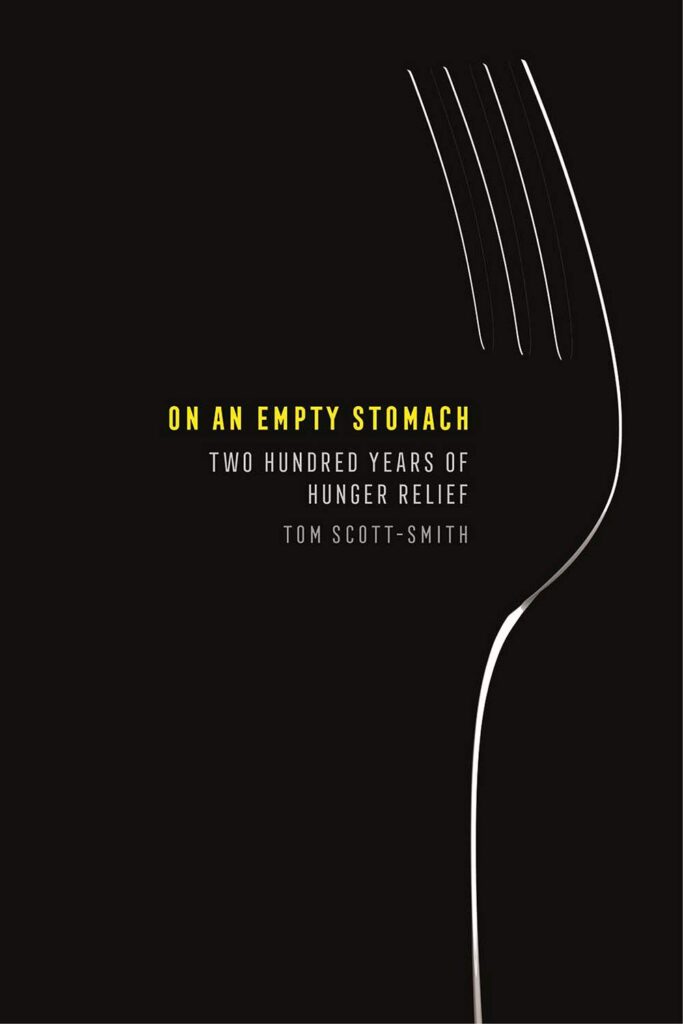Reviewed Book
On an Empty Stomach: Two Hundred Years of Hunger Relief By Tom Scott‐Smith, Ithaca, NY: Cornell University Press. 2020. pp. 288.

Karen Díaz Serrano
University of South Florida
Tom Scott-Smith argues in On an Empty Stomach that patterns of power and social-political conditions can influence how hunger is viewed and therefore determines how it is treated among individuals and populations. Such conditions can change based on historical events and who holds governmental or organizational power. In chronological order, Scott-Smith provides examples of how food relief has changed globally over the past 200 years and insight into why such changes occurred, all while advocating for leaders of current hunger relief programs to take these historical events into consideration and not repeat the same mistakes.
The book’s introduction shows how the idea of hunger was changing in the modern world, going back to the Victorian era. Scott-Smith illustrates how the British government used nutritional science to influence citizens in places such as workhouses, schools, and industrial canteens; later, this same science would be used in prisons and among soldiers. Hunger was not viewed as an individual problem at that time but as a problem that could be detrimental to populations; this started the idea of social nutrition and made hunger an international issue, with the League of Nations in the middle of it all. Since hunger was viewed as a population-wide problem, the most practical solution seemed to be standardizing the level of care that was given, whether that was through a soup kitchen that followed a strict process of feeding or at a refugee camp that treated malnutrition based on anthropometric indicators. Although this thought process occurred years ago, certain aspects of it are akin to the logistics involved with current hunger relief programs and how they provide aid. Scott-Smith then goes on to describe the many impacts the Second World War had on humanitarian nutrition, declaring that was when the turning point occurred in the history of humanitarian aid. He describes how starvation began to be viewed as a medical problem and that hunger solutions evolved into more medicalized, individualized, and rationalized approaches. The book concludes with a discussion of low modernism and how global hunger became more of a business opportunity for companies. However, many commercially viable devices and commodities failed during this time because they did not consider the importance of culture among the people they were trying to provide aid to. Scott-Smith takes a firm stance against the narrow metrics that are used in a crisis response and claims that, even during an emergency, failing to take culture into consideration will not lead to a successful intervention, especially when food is involved. He provides examples of how biomedicine was central to colonialism and how progress toward the study of hunger came at the expense of others, who were most often part of marginalized and impoverished groups.
Throughout the book, Scott-Smith references a diverse range of scholars, providing examples of interdisciplinary research. The book advocates for such work to continue among hunger relief workers, claiming that different disciplines can help build on each other to provide further solutions to the issue of hunger. This shows that while this book can be considered an anthropological text, its teaching could be used in other fields, such as history, global health, dietetics, and public health. Personally, I found this book to be refreshing and would recommend it for different disciplines because of the interdisciplinary focus.
Additionally, I appreciated Scott-Smith’s honesty when viewing humanitarian aid efforts and his acknowledgment that control and power are central to this work. There are plenty of examples where the process of providing humanitarian aid, or program failures due to funding complications, has been harmful to the population served. Scott-Smith’s viewpoint is not negative; he simply listed the facts of what was done and acknowledged that there was progress made. The book also includes information about what did not work and why it did not work, which could be helpful to those who are currently trying to work in this field and for the future. For example, the peanut paste Plumpy’nut was a great treatment for malnutrition because it tasted good and was easily packaged, whereas leaf protein concentrate was rejected because it was not palatable or an attractive product.
Although Scott-Smith does mention food banks and food pantries throughout his book, I was disappointed that he did focus more on how these types of programs have contributed to hunger relief. How food pantries have been organized and the food that has been distributed from them has dramatically changed throughout the years, from providing donated food to help those who are homeless to taking on a more “food is health” type of mindset and focusing on distributing more perishable types of food such as produce and lean meats, which are viewed as more healthful than canned goods. Volunteers still make up most of the labor force for these programs, even the people involved have changed, with an increasing number of dietitians being included on food bank payrolls. Locations have also changed, with food pantries now available in places other than just religious organizations, like hospitals and schools. For example, over the course of a few decades, Feeding America has become one of the largest charitable organizations that works to eradicate hunger, with many affiliated food banks throughout the United States.
Some of the critiques regarding past food relief efforts described in the book are similar to what food banks and pantries are currently facing, including how power shifts can occur among staff, volunteers, and recipients during the distribution of food. Viewing current food relief practices through a theoretical lens that involves biopower could help address these critiques of power and avoid harming participants of the food relief programs.